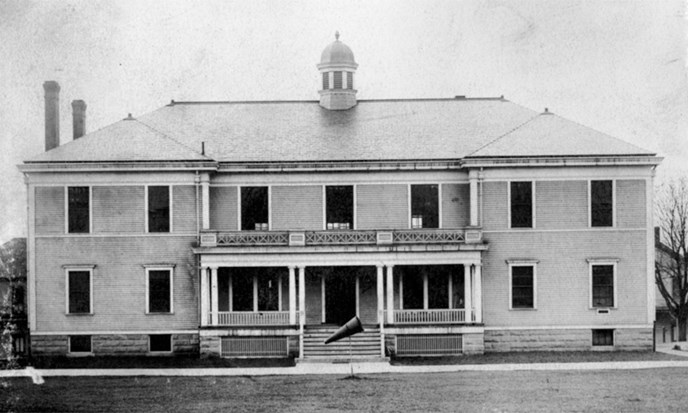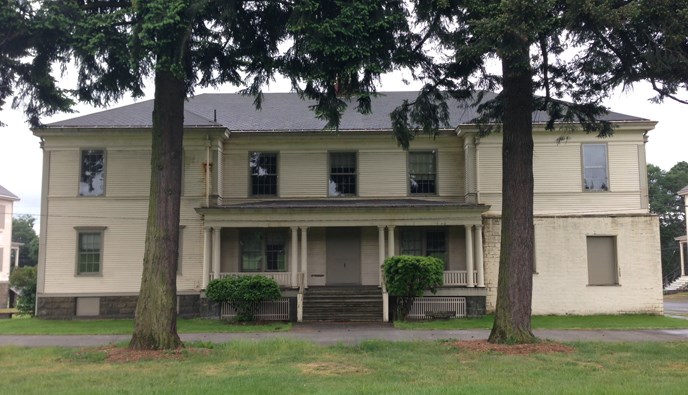|
Contact: Ray Cozby, Project Manager, Vancouver Barracks, 360.816.6238 Contact: Kristen Jontos, Business Manager, Vancouver Barracks, 360.816.6209 Contact: Alex Patterson, Facility Manager, Fort Vancouver NHS, 360.816.6221
Who: National Park Service at Fort Vancouver National Historic Site Where: East & South Vancouver Barracks, Fort Vancouver National Historic Site What: Major Projects Announced for Year 2 as a Unit of the National Park Service
VANCOUVER, WA--Superintendent Tracy Fortmann and Project Manager Ray Cozby today announced several upcoming projects for the East and South Vancouver Barracks unit of Fort Vancouver National Historic Site, set to highlight the second anniversary of the transfer of the historic grounds from the U.S. Department of Defense to the U.S. National Park Service (NPS). "We are excited to be beginning a second year of significant project work aimed to bring the East and South Barracks Master Plan to life," said Fortmann. "Although not as visible to the public, thorough utility and infrastructure improvements are critical for successful, long-term adaptive reuse of these historic buildings and grounds." "This is a complex project with many different facets," said Cozby, "and it is very rewarding to see important milestones planned, initiated, and achieved in these first critical years." Following significant achievements in the first year, and toward a goal of achieving the full potential of the site and opening buildings to the public, the National Park Service will complete several critical planning and infrastructure projects over the next twelve months. Utility Design and Site Planning Over the next year, the National Park Service will complete final design documents for the replacement and upgrade of all utilities in the East and South Vancouver Barracks. The antiquated systems that fail frequently--such as the water line shown in the video here-- will be redesigned to provide the required flow to all buildings for future occupants and also new fire alarm systems that will better protect the historic buildings. The final utility design will also relocate electrical systems underground, in a manner similar to that employed by the City of Vancouver in West Barracks. This project will likely be phased over time, with the most urgent work taking place first. In a related project, the site access design will be coordinated to align utility work with the newly designed road corridors. Safety for vehicles, bicyclists and pedestrians will be a primary focus of this project, as will protection of the cultural landscape and sensitive archaeology sites. Future implementation will likely occur in phases as well. Preservation Work on Building 991 Fort Vancouver NHS was successful in obtaining project funding for restoration and conservation work on the exterior surfaces and roof of the former post headquarters building in the East Barracks known as Building 991. With concurrence with the State Department of Archaeology and Historic Preservation, this effort will be the first in what the National Park Service expects to be a series of similar repairs and improvements to the exterior envelopes of the other historic buildings in the East and South Vancouver Barracks. Park staff will first prepare the building by removing an alteration to the exterior of the northwest corner of the first floor consisting of clay tile cladding to expose the original building fabric. This is consistent with guidance from a recent historic structures report that found through the review of old Army documents that this alteration to "harden" that corner of the building occurred around 1956. The project will also include contracted roofing and siding rehabilitation work, some structural upgrades, and repair of the integral gutter system. These are all critical systems which are important to protect the historic structure from damage from the elements. The building will be repainted appropriately to blend with the look of others throughout the Historic Reserve. As part of the painting project, NPS cultural resource staff has been taking paint samples for analysis from several historic buildings within East and South Barracks. This analysis, provided by a laboratory through a contract with the National Park Service, will document original finishes and color change through time for the building exteriors. After analysis, the paint samples will be archived within the park's museum collection. This process is similar to the one used successfully by the National Park Service in the past to establish original paint colors inside the reconstructed Chief Factor's House and Counting House structures onsite. "To our knowledge, this level of paint analysis of the historic buildings throughout the East Barracks has never been done before," said Fortmann, "and we believe this analysis will be very informative. It will give us a better understanding of the look and feel of the post through the many chapters of its history." With several different paint color schemes applied to the buildings of Vancouver Barracks since 1900, the National Park Service plans to share this evolution of color through future interpretive media. Park staff will begin preparatory work on the building's northwest corner as early as June with the roofing and painting following later in the summer. Development of Engineering Evaluation/Cost Analysis Plan Through a contract with the National Park Service, additional soil sampling and investigation of the East and South Vancouver Barracks site will be undertaken to provide data for an Engineering Evaluation/Cost Analysis (EE/CA) planning document. This work, which is expected to be completed this year, includes the collection of 180 additional soil samples that are being analyzed and the development of response alternatives. The analysis will be used to confirm preliminary NPS findings that the majority of the site requires no remedial cleanup action at all and the primary issue to address is as a result of flaking paint from the area's buildings. This site is rich in well-preserved archaeological resources which will be a significant factor in determining an appropriate response plan. "Ultimately, addressing 'first things first,' it was critical to initiate the EE/CA process early so we can work to establish a plan that identifies the extent, type, and duration of cleanup," said Cozby, " and also take the necessary steps to protect and preserve the Barracks' historic landscape, structures, and archaeological resources." The National Park Service expects that this plan, which will include a prefered remedial alternative created through public input, will be completed by October 1, 2013. Public Archaeology Field School Centered on South Barracks Activities of the National Park Service's annual Public Archaeology Field School will center around South Barracks this summer. Students from throughout the nation will provide critical archaeological survey and excavation work to inform a reconstruction of a Village house and provide information for the restoration of the Village (Kanaka Village) landscape and the interpretation of this important international resource. The field school is a partnership with Portland State University, Washington State University Vancouver, and the Oregon Archaeological Society and will operate onsite Tuesdays through Saturdays from June 18 through August 3, 2013. The field school is public-oriented and all are invited to visit, observe, and ask questions of participating archaeologists. "It is a wonderful opportunity to meet and speak with professional archaeologists and their students," said Fortmann. -END- BACKGROUND: Fort Vancouver National Historic Site, a unit of the National Park Service, is at the heart of the Vancouver National Historic Reserve. The Vancouver National Historic Reserve brings together a national park, a premier archaeological site, the region's first military post, an international fur trade emporium, one of the oldest operating airfields, the first national historic site west of the Mississippi River, and a waterfront trail and environmental center on the banks of the Columbia River. The partners of the Reserve teach visitors about the fur trade, early military life, natural history, and pioneers in aviation, all within the context of Vancouver's role in regional and national development. The Reserve's vast array of public programs -- including living history events, cultural demonstrations, exhibits, active archaeology, and other special events and activities -- create a dynamic, fun, and unique tourist destination for people of all ages. 
Fort Vancouver National Historic Site 
NPS Photo by Greg Shine |
Last updated: February 28, 2015
